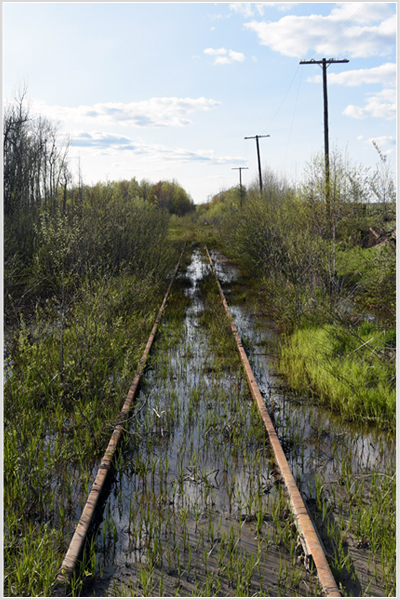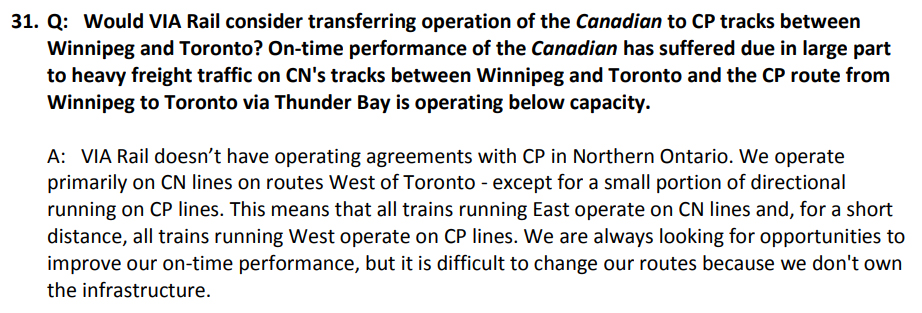
The familiar sound of a passenger train can once again be heard in areas of Northern Ontario that are served by VIA Rail Canada. The Crown corporation officially restored passenger rail services to pre-pandemic levels after more than two years of on again, off again, limited or indefinitely suspended train schedules.
Life appears to have returned to normal … at least for the time being.
For those who require essential services in larger cities or access to remote regions of the province, there are now two frequencies a week on the Canadian and three between Sudbury and White River.
This should be an opportunity for Northerners to breathe a sigh of relief … though can they really afford to?
Rail services in Northern Ontario — what’s left of them anyway — continue to be difficult to use, are susceptible to significant delays and remain vulnerable to lobbyists who want to see them disappear outright.
Disconnected en masse
VIA Rail, and by extension the federal government, have made train travel arbitrarily complicated. Of the ten largest northern cities, Greater Sudbury is the only one directly connected by intercity passenger rail.
While Dryden and Kenora are within a half hour’s drive from their closest respective stops, there’s no public transportation available to and from. It’s impractical and potentially unsafe to wait for the Canadian’s arrival outside, in front of a sign post in a wooded area, during the middle of the night.
| City | Population | Passenger Rail Service |
|---|---|---|
| Greater Sudbury | 166 004 | Has service |
| Thunder Bay | 108 843 | None since 1990 |
| Sault-Ste-Marie | 72 051 | None since 2015 (ACR) |
| North Bay | 52 662 | None since 2012 (ONR) |
| Timmins | 41 145 | None since 2012* (ONR) |
| Kenora | 14 967 | None since 1990 |
| West Nipissing | 14 583 | None since 1990 |
| Temiskaming Shores | 9 634 | None since 2012 (ONR) |
| Kapuskasing | 8 057 | None since 1990 (VIA) / 2012* (ONR) |
| Dryden | 7 388 | None since 1990 |
VIA’s Sudbury-White River train inexplicably ends in a township of 550, rather than concluding its journey a few hours further up the Canadian Pacific Railway to Thunder Bay.
Despite reductions in bus service to communities along Lake Superior, both VIA and the Minister of Transport appear uninterested in even examining the issue of extending rail service to the largest city in the Northwest.
Northerners have grown tired of repeated excuses and lip service. VIA and the government can surely do better than this.
Dependable? It depends …
The Canadian’s on-time performance over the last decade has diminished at an alarming rate. It went from operating reliably 84% of the time, to as low as 8% in 2017.
While it has since rebounded, travellers never know whether or not they will depart or arrive at their destinations as planned. The delays plaguing VIA’s flagship train in 2021 ranged from mere minutes to nearly 14 hours!
In a country as wealthy and resourceful as Canada, I have difficulty believing a travel advisory is the best solution the federal government can come up with.

Disappearing act?
The Frontier Centre for Public Policy recently published a letter suggesting that VIA Rail either be closed or sold. What they haven’t considered are some of the existing challenges faced by everyday people who rely on this public asset.
How many times has the spokesperson driven through Northern Ontario in the dead of winter only to find that the lone highway that connects both ends of the country is closed due to an accident or a jackknifed transport truck?
How often have they spent a night on an uncomfortable bus in order to get medical treatments ten or more hours away from home? How about living in a community with no roads in or out and needing an affordable means of transport to pick up groceries?
Divestment of public assets like VIA would only make life more difficult for Northerners and rural Canadians alike.
We’re still recovering from the damage caused by two attempted fire sales of the Ontario Northland Transportation Commission. A Temiskaming Region Travel Survey Report identifies the Shutting down of the Northlander Train as one of the greatest barriers to travel for medical reasons.
Rather than cutback or eliminate services, what VIA needs is some reform and investement.
The cancellation of the Environment Minister’s cross-country train tour on the climate crisis — due to a lack of service — proves just how out of touch the federal government is with the issues and deficiencies of intercity transportation in Canada.
The increased number of volatile weather events and forest fires, the partial collapse of the Nipigon bridge and pandemic related border closures are examples of how vulnerable our infrastructure and supply chains truly are.
Complacency is going to be our country’s downfall.

Discover more from Northern Tracks Blog
Subscribe to get the latest posts sent to your email.






I’ve suggested to the Premier and Minister Mulroney that one of the cheapest ways to provide passenger rail service to the m ajority of Northerners is to sit down with VIA and CP Rail to work out a plan to convert then Canadia n to CP from Toronto to Winnipeg. It is a more scenic route and captures 10 times the population than the CN route. The Budd car service could be switched over to CN. Have not had a reply to this request yet.
LikeLike
“How about living in a community with no roads in or out and needing an affordable means of transport to pick up groceries?” If people choose to live in remote locations then they have to realize services will not be available. If they want them then they must pay for them. They can always move to a community that has them or if they feel they must live far from everybody else then there are things that will not be available. It is their choice.
LikeLike
Applying the same logic then, people who can’t afford to rent or own a home in the larger cities should just move somewhere where they can find something within their budget. After all, it’s their choice to live in an area where homes are priced at or above a million dollars. Interest rates set by the Bank of Canada were at record lows for the past ten or more years.
LikeLike
Alot of those communities have been there longer than some cities.. this their home, what if someone asked u to leave your home…and your not only talking remote north, it’s sudbury, north bay, huntsville etc. Lack of services..so everyone move to the city…lol
LikeLike
With all the carbon footprint global warming ,money makers, why not do like Europe, Double track the rail if a structure,for major links, and go electric, and electric side line to smaller communities,,,expensive,yes, but worth it ,,,
LikeLike